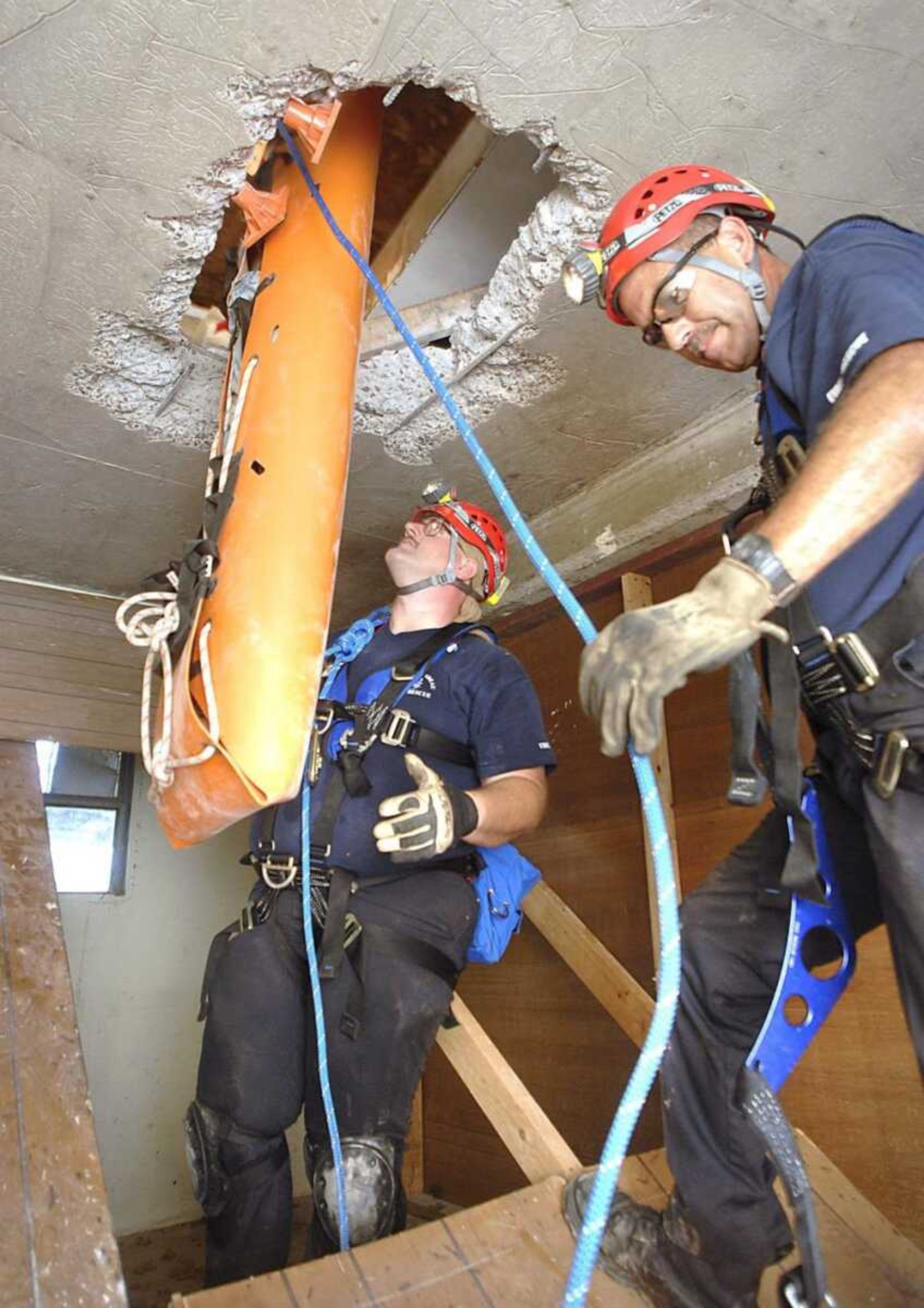The earth shook. Communication towers twisted and fell. Roads cracked, and two major buildings caught fire. That is what authorities were told Tuesday at the beginning of a state-run, three-day earthquake exercise designed to test the reaction and preparedness of the region in the wake of a major earthquake.
The Missouri State Emergency Management Agency organized the scenario, which was funded by the Missouri Department of Public Safety's Office of Homeland Security. The emphasis was on 47 counties in eastern and Southeast Missouri. All of the counties had tabletop exercises, but Cape Girardeau and Sikeston were the only two exercises in the region where workers put their skills to use in live situations, said Mark Winkler, area coordinator for SEMA.
The tabletop exercise was the response phase of the simulation of a magnitude-7.7 earthquake along the New Madrid fault from northeastern Arkansas to Dyersburg, Tenn.
"That was the first time the department heads knew the extent of the instance," Mark Hasheider, assistant fire chief and emergency management director in Cape Girardeau, said at Cape Girardeau's new Emergency Operations Center on Tuesday.
On Thursday, firefighters from five surrounding counties sawed through walls and crawled under a collapsed carport to rescue the "victims" trapped inside a house at Mount Auburn and Bloomfield roads in Cape Girardeau.
"You've got to be very disciplined," said Capt. Brad Dillow of the Cape Girardeau Fire Department. "Even though we've got the victim screaming at us, family members screaming at us, we have to be very disciplined, very precise in what we're doing."
Dillow teaches technical rescue at the University of Missouri and helped set up Thursday's exercise.
Sikeston public safety workers rescued two victims -- dummies -- from a pile of metal and glass that was once a Toyota Corolla. They set up struts to stabilize the carport and free the dummies from the wreckage.
Other rescue workers cut through brick walls to reach victims in the basement or tunneled through several interior walls to find more victims inside the house.
The three-day state exercise ran parallel to, but was not part of, a national drill called Spills of National Significance, which simulated an earthquake and resulting oil spill into the Mississippi River.
The idea came two years ago from state officials who watched the "miserable level of response" to Hurricane Katrina, according to U.S. Rep. Jo Ann Emerson, R-Mo. She said she wanted to be sure a natural disaster in her home state would be handled efficiently.
"In any kind of federal emergency, there has to be a really well-coordinated effort," Emerson said by phone from Washington, D.C.
Gov. Matt Blunt echoed Emerson's concern Thursday after he toured the collapsed house.
A catastrophic response plan did not exist two years ago, Blunt said. After Katrina, Blunt made calls to get the ball rolling on developing a sufficient response plan. "The last three days have been testing that plan," he said.
The government has a "basic obligation" to respond quickly during a disaster, Blunt said.
The exercise gave officials and rescuers a chance to practice skills that were otherwise hypothetical, Hasheider said.
"It's gone really well," he said Thursday.
Workers had to overcome obstacles like unstable roofs and unlevel ground during Thursday's rescue operation. During the tabletop exercise, department heads had to figure out how to get trucks past roadblocks and deliver water to or simply communicate with the public.
Although building codes are now in place to minimize structural damage to buildings and scientists and others say a major earthquake is an eventual certainty, some researchers believe the threat is exaggerated.
The number of earthquakes is decreasing over time, said Seth Stein, a professor at Northwestern University. Stein believes the small earthquakes that occur now are aftershocks of the mammoth 1812 earthquake and that the New Madrid fault system might be shutting down.
An earthquake is the release of the deformation of moving ground. Stein equates it to the pop of a spring that has been under pressure.
"We can see that the spring is not being squeezed," he said. "The ground just isn't moving."
Stein said faults have been known to shut down, although scientists cannot explain why.
"It's not a given that that's what we're seeing in the New Madrid," Stein said. "But we know the general phenomenon is real."
Some say a small chance of a quake is enough to take notice.
"I'd sure like to be prepared for one and not have one than not be prepared for one and have one strike," Emerson said. "We can't sit around and wait for something to happen."
charris@semissourian.com
335-6611, extension 246
Connect with the Southeast Missourian Newsroom:
For corrections to this story or other insights for the editor, click here. To submit a letter to the editor, click here. To learn about the Southeast Missourian’s AI Policy, click here.








